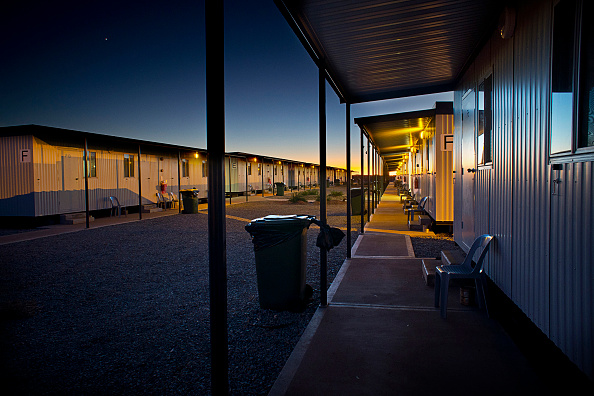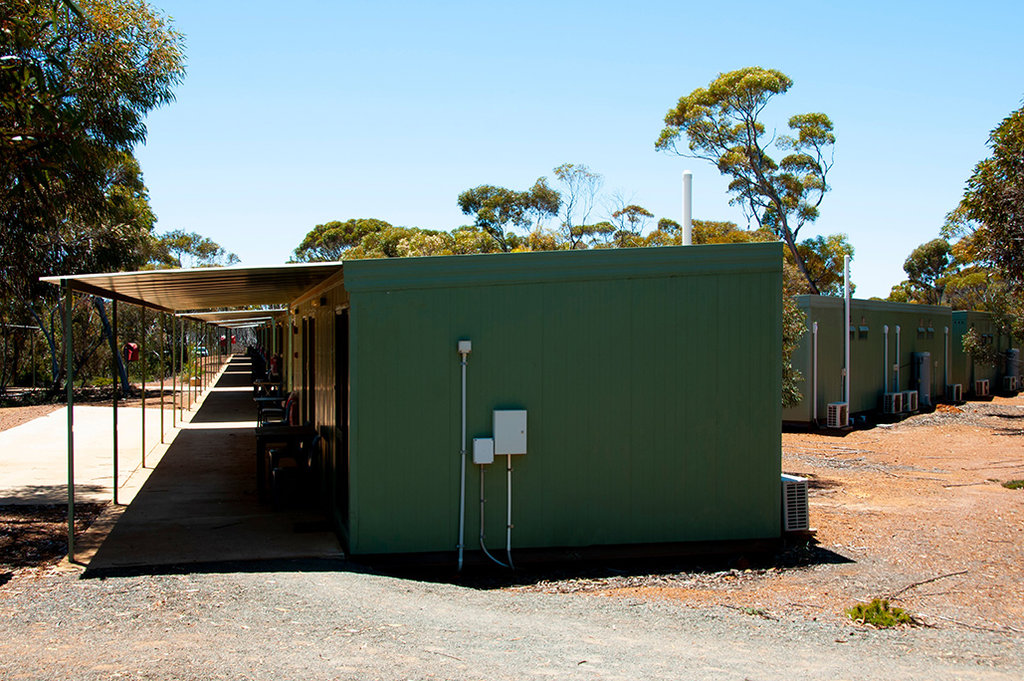Feature
Is FIFO mining incompatible with fair treatment of workers?
Giles Crosse presents the evidence against fly-in, fly out work and the initiatives hoping to scrutinise and change a hazardous culture.

Caption: Mount Magnet FIFO accommodation. Credit: Auscape/Universal Images Group via Getty Images
Fly-in fly-out (FIFO) work, where workers live on-site in weeks-long rotations, has acted as the cornerstone of many Australian mines for years. Now, serious questions are being asked about its ethics and risks.
With some of Australia’s biggest miners facing allegations of harassment at their FIFO sites, the industry must better balance FIFO work's productivity against the needs of its workers.
What is FIFO?
When it comes to ethics, risk, safety and harassment, FIFO is becoming more and more controversial.
Commonly, FIFO is used in the mining, oil and gas drilling industries, as mines and wells can lie far from the nearest settlement. Generally, such sites use portable buildings, aiding clear-up after the end of operations.
In practical terms, the practice might not immediately seem problematic. If workers act as they would elsewhere, why should FIFO sites pose a problem? The issue appears that FIFO sites act as secluded corners of society, away from the social expectations and passive scrutiny seen in normal life. This can encourage toxic cultures and heighten abuse, for a number of psychological, logistical and geographical reasons.

Caption: Mining camp accomodation. Credit: Amwo via Shutterstock
FIFO: cash vs conscience?
In 2012, Fortescue Metals Group told an inquiry that it would cost an additional A$100,000 per worker per year to employ staff in residential positions, rather than as FIFO workers. for perspective, this would mean that switching the company’s 330 workers at its Port Hedland facility away from FIFO work would cost the company an additional A$33m per year.
Nine years after the first, another inquiry was formed to investigate the potential harms of FIFO work. Quite apart from the damage to individuals and the reputation of a company, chief executive of Western Australia’s Chamber of Minerals and Energy Paul Everingham made the point that FIFO abuses reflect poorly on the industry as a whole. He summarised this in saying: “There is a lot of public talk around improving things by getting greater diversity onto mine sites, but what young impressionable girl would want to work on a mine site, particularly when we have sexual harassment and assault going on?”
Last year, Rio Tinto released its own report into its workplace culture, following allegations of sexual harassment at several of its FIFO sites. It revealed various experiences of bullying, sexual harassment and racism by men and women working at different Rio Tinto sites.
Quotes from female workers vary from “I was bullied over and over again,” to “You look like a boy”.
It shows female employees working on FIFO were more likely to experience bullying than their male colleagues. Women in FIFO work also experienced significantly higher rates of sexual harassment. Other massive issues surrounding sexuality, race and general toxicity come to light in the Rio report. Quotes from female workers vary from “I was bullied over and over again,” to “you look like a boy”.
Another quote read: “As a lesbian, I’m often treated like ‘one of the guys’ – they share their fantasies with you and are not afraid to make vulgar comments in front of you. I received heaps of comments that "you just haven't met the right guy", and instances of men wanting to come back to your room. I didn’t feel unsafe though. It was just frustrating.”
Whether the comments are frustrating, unsafe, or bringing some other harm, most would agree they should not happen. The question remains whether a practice that makes room for these comments ought to be operating at all.
New alternatives to FIFO work
In response, some companies seek to manage the issues of FIFO. Mineral Resources has unveiled a prototype for resort-style accommodation for FIFO in the mining industry that it hopes will tackle some of the social issues around the practice.
The company has ordered 750 locally fabricated rooms, with each spanning 45 square metres of living space. This makes them three times larger than traditional FIFO accommodation.
The rooms feature a queen size bed, separate ensuite, kitchenette, lounge and laundry with washer and dryer, meaning there’s no need for a communal laundry system.
We want to redefine what it means to be a FIFO worker by creating a home-away-from-home and a genuine community environment for our people.
Mineral Resources chief people and shared services officer Bronwyn Grieve said: “We want to redefine what it means to be a FIFO worker by creating a home-away-from-home and a genuine community environment for our people. To do that, we must have high-quality, comfortable and secure accommodation. That’s exactly what these pods will deliver; they are a game-changer.”
The rooms have been designed for single people or couples, with the aim of encouraging a more diverse workforce. Each pair of rooms, known as a “pod”, will be linked by walkways and configured like a resort, with shared gathering spaces and barbecue areas.

Caption: Mineral Resources’ FIFO “pods”. Credit: Mineral Resources.
Mineral Resources only announced its prototype in December. In its first deployment, locals criticised the development for its potential impact on traffic, also saying that it would occupy prime beachfront. For a true comparison to other FIFO developments, metrics on whether it can reduce cultural toxicity on the ground will be needed, in time.
Peace of mind
An interesting 2023 study by Edith Cowan University finds that sleep loss was significantly greater following FIFO-style day shift and night shift work compared to days off, resulting in a 20% reduced alertness across the 14 consecutive shifts at the mining operation.
Further, shift workers reported a high prevalence of sleep disorders, including shift work disorder among 44% of workers, obstructive sleep apnoea among 31% and insomnia for 8%. A high proportion of shift workers had obesity problems, with 23% having a body mass index of greater than 30kg/m2, and 36% consuming hazardous levels of alcohol.
MINE Australia is not a scientific journal, but it takes little analysis to imagine that sleep-deprived or drunk FIFO staff might be more likely to make poor choices than their healthier colleagues. This being the case, a kinder environment of the like envisaged by Mineral Resources would logically offer more respite, calmer moods and safer mining practice as a result.
Risks all too evident
In May 2023 a former fly-in, fly-out worker was found guilty of raping a colleague at a remote mine site in Western Australia, in a case that came to the public's attention amid wide-ranging allegations of sexual assaults and harassment within the mining industry.
The assault, writes ABC, happened in November 2020 after the two had been drinking and socialising with friends on a night that marked their transition from a week of day shifts to a week of night shifts.
Partially in response to this, Western Australia developed the “Enough is Enough” report on sexual harassment against women in the FIFO mining industry. It states that FIFO work has long had most, if not all, of the major risk factors for sexual harassment in the workplace. These include poor culture, including the general “tone” of a workplace, especially where incivility is common and accepted as “the way we do things here”, as well as acceptance by leaders of poor behaviours, protection of “high value” workers above others, and the misuse of alcohol and drugs.
Sexual harassment has long been and continues to be prevalent across the FIFO industry.
Disrespect for women generally, alongside gender inequality, stereotypical relationships between peers and aggressive male-male peer relationships is another issue, as well as power disparity in the workplace, where managers and supervisors have relatively unfettered power over dismissal, promotion or reward.
It concluded that sexual harassment has long been and continues to be prevalent across the FIFO industry. Its entanglement with the mining industry is fundamental, and the industry is in turn essential to the economy of Western Australia, as well as a large part of all aspects of life in the state. Making otherwise unviable resources worth developing, FIFO work brings in hundreds of billions of dollars every year. Can this huge wealth creation machine ever sit comfortably with the abuses it enables?
ESG and FIFO in the remote corners of Australia
There appears to be a compelling argument for the wider and deeper use of ESG reporting in either ending or regulating FIFO. Among other uses, ESG officers exist to prevent conflicts of interest between profit and human, environmental or social good.
Put simply, ESG reporting that illustrates the risk of discrimination, abuse and other harms in FIFO mining, placed in front of global shareholders at annual meetings, could either end the practice entirely or require drastic improvements from executive suites tasked with maintaining share price.
While mining companies rarely answer directly to consumers, the rise of ESG investing and the social contract with local communities puts a higher price on the importance of preventing abuse in FIFO workplaces. Showing strict reporting and metrics on conduct to company leaders can inform change, but showing these shareholders allows them to vote with their investments on practices that they will, or will not, accept to get their next dollar.